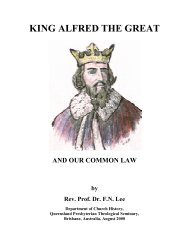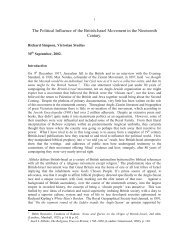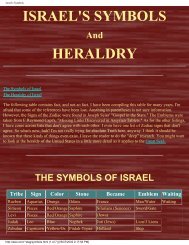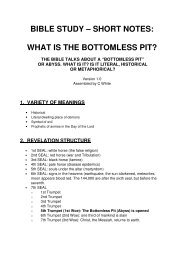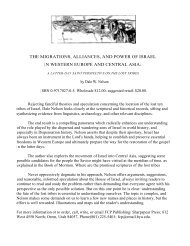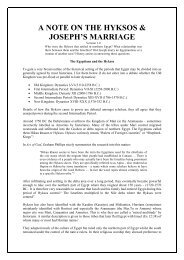The Throne of Britain: Its Biblical Origin and Future - Origin of Nations
The Throne of Britain: Its Biblical Origin and Future - Origin of Nations
The Throne of Britain: Its Biblical Origin and Future - Origin of Nations
You also want an ePaper? Increase the reach of your titles
YUMPU automatically turns print PDFs into web optimized ePapers that Google loves.
founder <strong>of</strong> Athens in Greek mythology. This is, in fact, pro<strong>of</strong> positive that Irel<strong>and</strong>’s traditional<br />
histories link its Milesians to those <strong>of</strong> the Aegean. For besides the mention <strong>of</strong> Cecrops, we have<br />
already seen that the Milesians <strong>of</strong> Asia Minor traced their descent from Neleus, the ruler <strong>of</strong><br />
Mycenaean Pylos on the Ionian Sea (who, as with other Mycenaean rulers, was likely <strong>of</strong> Jewish<br />
descent). So Milesius was probably not the actual name <strong>of</strong> the founder <strong>of</strong> the Milesian dynasty in<br />
Irel<strong>and</strong>. Rather, the name Milesius or Miledh itself meant Milesian (one from Miletus). Thus, it most<br />
likely did not just mean “soldier.”<br />
Likewise, the name Golamh <strong>and</strong> its variants are not personal names. Rather, they simply denote<br />
nationality, coming from the same origin as Gaul <strong>and</strong> Gael. As explained in our booklet <strong>The</strong> United<br />
States <strong>and</strong> <strong>Britain</strong> in Bible Prophecy, these names denote w<strong>and</strong>ering Israelites—as did the term<br />
Scythian (“Linguistic Links: What’s in a Name,” p. 30). Interestingly, as noted elsewhere in this<br />
publication, Milesius was said to descend from the king <strong>of</strong> Scythia, one Feinius Farsaidh. But this may<br />
not be an actual personal name either. “Feinius appears to be the same word as Feni, a name for<br />
Irel<strong>and</strong>’s earliest Celtic inhabitants” (Ellis, p. 228). <strong>The</strong>se were probably the Phoenicians—many <strong>of</strong><br />
whom were Israelites.<br />
Continuing on, the high kings <strong>of</strong> Irel<strong>and</strong> “claimed their descent from the two sons <strong>of</strong> Milesius,<br />
Eremon <strong>and</strong> Eber Fionn, who were progenitors <strong>of</strong> the Gaels in Irel<strong>and</strong> <strong>and</strong> who divided Irel<strong>and</strong><br />
between them—Eremon ruling in the north <strong>and</strong> Eber Fionn in the south” (p. 5). Again, these may<br />
not have been personal names. We will later look at the meaning <strong>of</strong> Eremon or Heremon, which may<br />
have been a real name or at least a title. But Eber Fionn or Eber Finn may simply denote “Hebrew<br />
Phoenician.” Whatever the case, the most likely conclusion regarding the identity <strong>of</strong> the Milesian<br />
invaders <strong>of</strong> Irel<strong>and</strong> is that they were Israelites—yet not just any Israelites, but Zarhite Jewish royalty<br />
from Miletus.<br />
<strong>The</strong> people <strong>of</strong> the Red H<strong>and</strong><br />
<strong>The</strong> Trojans were forced out <strong>of</strong> the Aegean region through a series <strong>of</strong> national conflicts—one <strong>of</strong><br />
which is presented to us in the famous Trojan War <strong>of</strong> Homer’s Iliad, which occurred around 1200<br />
B.C. Some refugees seem to have migrated north into Europe via the Black Sea. Others from Troy<br />
migrated south to the area <strong>of</strong> Miletus (see Roberta Harris, <strong>The</strong> World <strong>of</strong> the Bible, 1995, map on p.<br />
63). And still other Trojans appear to have traveled west—even all the way to Spain <strong>and</strong> France,<br />
some <strong>of</strong> them eventually migrating to <strong>Britain</strong> (see Appendix 5: “Brutus <strong>and</strong> the Covenant L<strong>and</strong>”).<br />
And we know that Milesians also migrated to Spain from the Eastern Mediterranean at a later<br />
time—ending up in Irel<strong>and</strong>.<br />
It is amazing that two royal lines from Zerah—the Trojan dynasty <strong>and</strong> the Athenian-Milesian<br />
dynasty—both passed through the Iberian Peninsula. Arriving here, these settlers may have sailed up<br />
the Ebro River <strong>and</strong>, upon its banks, founded the city <strong>of</strong> Saragossa—which some have identified as<br />
“Zara-gassa,” possibly meaning “stronghold <strong>of</strong> Zerah.”<br />
Strengthening the identification with Zerah is the fact that the Milesians rulers who assumed the<br />
Irish throne were known as the people <strong>of</strong> the “Red H<strong>and</strong>.” In fact, the Red H<strong>and</strong> appears even today<br />
on the <strong>of</strong>ficial flag <strong>of</strong> Northern Irel<strong>and</strong> <strong>and</strong> on the coats <strong>of</strong> arms <strong>of</strong> many Irish <strong>and</strong> Scottish clans.<br />
This “ancient regional emblem [is known as] the blood-red right h<strong>and</strong> <strong>of</strong> Ulster” (Idrisyn Evans,<br />
<strong>The</strong> Observer’s Book <strong>of</strong> Flags, 1959, 1975, p. 28)—Ulster being the northern province <strong>of</strong> Irel<strong>and</strong><br />
through which the high kingship was later transferred to Scotl<strong>and</strong>.<br />
An old story explains the origin <strong>of</strong> Ulster’s heraldic symbol this way: “A quarrel arose between<br />
Eremon <strong>and</strong> Eber over the right to rule all Irel<strong>and</strong> <strong>and</strong> it continued through their descendants.<br />
Eremon <strong>and</strong> Eber, so legend has it, originally made a wager on which <strong>of</strong> them would reach Irel<strong>and</strong><br />
first. Realizing that Eber was about to reach the shore before him, Eremon is said to have cut <strong>of</strong>f his<br />
h<strong>and</strong> <strong>and</strong> thrown it onto the shore, claiming to have won the bet. <strong>The</strong>reafter the O’Neill kings [<strong>of</strong><br />
Eremon’s line, named after the Milesian ancestor Niul <strong>and</strong> a later king in this line named Niall]<br />
adopted a symbol <strong>of</strong> a Red H<strong>and</strong>. But a h<strong>and</strong> reaching forth is a symbol <strong>of</strong> kingship, <strong>and</strong> the severed<br />
h<strong>and</strong> is a fanciful tale” (Ellis p. 228).<br />
Yes, it makes for interesting storytelling—<strong>and</strong> would account for the blood-red h<strong>and</strong>. Yet it<br />
should be obvious that this event did not really happen—or at least did not happen this way. No<br />
ruling chieftain would have cut <strong>of</strong>f his own h<strong>and</strong> to win a race unless he were insane—in which case<br />
he would likely have been deposed. If there is any truth in the story at all, we should recognize that<br />
instead <strong>of</strong> tossing his own h<strong>and</strong> ashore, Eremon had the emblem <strong>of</strong> the blood-red h<strong>and</strong> that<br />
- 11 -




